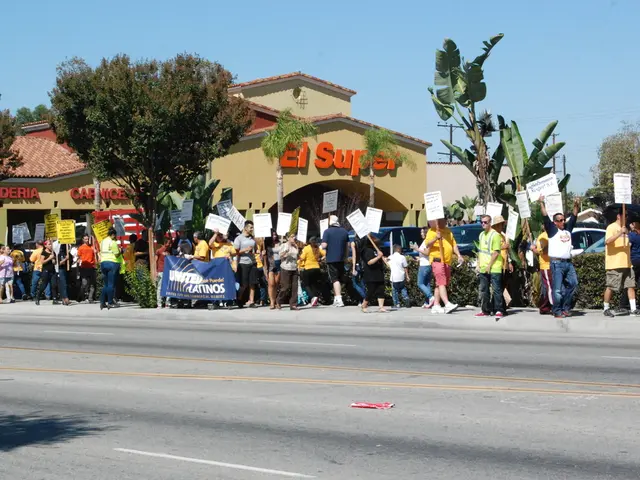Strategies for Corporations to Combat Sudden Fluctuations in Pharmaceutical Market Integrity
Inthe cutthroat world of American pharmaceuticals, a shady dance between manufacturers and pharmacy benefits managers (PBMs) is threatening to topple the delicate equilibrium between rewarding innovation and reducing patient costs.
Recently, some PBMs have wielded their clout to either snub biosimilars altogether or favor costlier ones produced by their own corporate parents. This dance has resulted in patients and businesses footing an unexpected bill, stifled innovation, and a crippled economy—with biosimilar savings amounting to a staggering $38.4 billion below projections from 2021 to 2025, according to the American Journal of Managed Care. To understand the tricks played by drug intermediaries, one merely needs to follow the headlines.
In his book "The Great American Drug Deal: A New Prescription for Innovative and Affordable Medicines", biotechnology thought leader Peter Kolchinsky offers a vision of a system that allows drugs to enjoy a period of patent protection to foster research and development. But once the patent expires, generics should be introduced to drive down prices and make medications more accessible to the masses. To Kolchinsky, the shift from brand-name to generic medications serves as a delicate equilibrium between making lifesaving treatments affordable while maintaining a competitive, innovative pharmaceutical industry.
The Role of Biosimilars
Over the past decade, biosimilars have filled the market to provide safe, FDA-approved counterparts of specialty drugs. While they differ from generics in composition, approval process, and standards, they share a similarity: They can be manufactured and approved by other drug companies once a specialty medication's patent expiration date arrives, promising lower costs.
In Europe, the introduction of biosimilars led to price reductions of up to 80% for certain medications. The American healthcare system had high hopes for similar results, forecasting billions in savings for patients and insurers alike.
The American Ecosystem
Sadly, biosimilars have failed to meet expectations in the American market. The culprit? PBMs and their influence over the drug ecosystem. PBMs, initially established in the late 1950s to help health plans manage prescription drug costs, have morphed into powerful entities with considerable sway over drug access and affordability.
As gatekeepers of formularies—lists that dictate what drugs health plans will cover—PBMs have the power to sway patient transitions from branded medications to cheaper biosimilars or generics by adding those alternatives to their formularies. Instead, they often leverage their power to keep patients on pricey drugs. This is because PBMs typically derive a portion of their revenue from manufacturer rebates offered on brand-name drugs. The higher the list price on the drug, the larger the rebate, making it more profitable for PBMs to keep patients on costlier medications.
A Case Study
The tale of Humira demonstrates this. Prior to its biosimilars hitting the market in 2023, Humira brought in a staggering $20 billion in annual sales for manufacturer AbbVie. In the wake of its biosimilars appearing on the market in 2023, there was little to no uptake on the part of big PBMs. To encourage formulary placement, some manufacturers even took the unusual step of offering biosimilars at two different price points. For example, manufacturer Amgen launched its version of Humira's biosimilar, Amjevita, at two price points: the first at $1,557 per 40mg dose, representing a 55% discount from Humira's list price of $3,461, and the second, more expensive option at $3,288 per 40mg dose, offering a mere 5% discount.
Why does offering the same drug at two different price points benefit the manufacturers? Because the costlier option likely came with a larger rebate, ensuring more revenue for the PBM. It's important to note that this larger rebate did not translate into lower net prices for the costlier Amjevita, making it the most cost-effective option within reach.
CVS also took a similar approach by creating a drug manufacturer, Cordavis, and entering into partnerships with others to produce and sell drugs through its PBM-owned specialty pharmacy. (Full disclosure: CVS is a part of our company's pharmacy network, and our members can fill prescriptions at CVS Pharmacy locations.) One of its products is Humira's biosimilar, Hyrimoz. According to CVS, it has removed Humira from its national formularies and managed to convert 97% of its patients to Hyrimoz. While Hyrimoz is more affordable than Humira, it's not the cheapest option available, raising concerns about antitrust practices that could deter investment in biosimilar research and development.
Moving Forward
If left unchecked, the grip of PBMs over the American healthcare system could mean higher drug costs and diminished returns on drug innovation. By keeping patients on biosimilars while limiting competition, some PBMs are putting their revenue streams before market access and affordability. Without a commitment to transparency, we risk stifling biosimilar innovation and depriving patients of future advancements and cost-saving alternatives.
As CEOs and heads of benefits, it's high time to take charge. You don't have to stand back and let this continue—push for transparency, demand better, and find partners who will deliver.
This isn't just about balancing budgets—it's about ensuring that the healthcare system progresses because the most effective therapies thrive on their own merit. The decisions you make today have a direct impact on the healthcare landscape tomorrow.
By demanding transparency and supporting competition, organizations can help dismantle the barriers that stifle biosimilar innovation. This could lead to a more dynamic marketplace where new, cost-effective therapies can flourish—one that guarantees breakthrough treatments for all.
The Forbes Business Council is a premier networking and growth organization for business owners and leaders. Do you qualify?
- Jake Frenz, a biotechnology expert, expressed concern that pharma benefits managers (PBMs) often favor costlier biosimilars or generic drugs produced by their own corporate parents, leading to increased patient and business costs by 2025, according to the American Journal of Managed Care projections.
- In his book "The Great American Drug Deal," Frenz advocated for a system that allows drugs to benefit from patent protection to foster innovation, while promoting the introduction of generic medications once the patent expires to drive down prices and make medications more accessible.
- Despite biosimilars' potential to save billions for patients and insurers, the American healthcare system has been plagued by stifled biosimilar adoption due to PBM influence, with Jake Frenz urging CEOs and heads of benefits to demand transparency, push for better practices, and seek partners who prioritize market access and affordability to ensure a more dynamic, cost-effective marketplace for future advancements.







